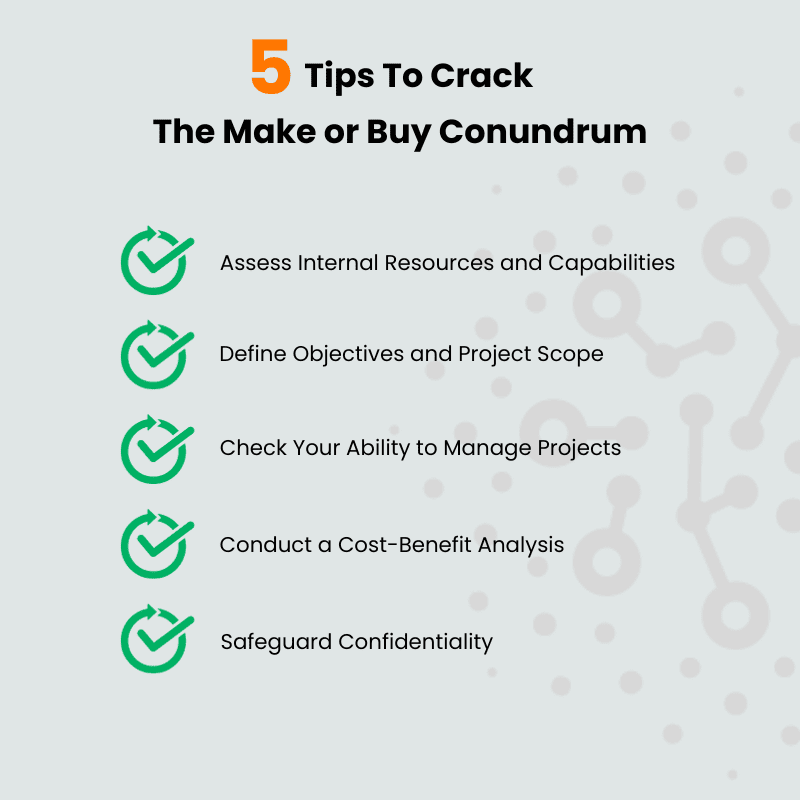When you need to make a decision that impacts the trajectory of your business, the choice between utilizing your internal resources or engaging external consultants stands as both pivotal and perplexing, particularly in the context of “make-or-buy in consulting.”
It’s the age-old quandary of whether to harness the power of internal resources or seek the sagacious counsel of external consultants. This decision finds itself at the crossroads of strategy and pragmatism, where every organization must navigate the labyrinth of operating budgets with the finesse of a seasoned conductor.
Yogi Berra, a man renowned for his unintentional but endlessly amusing quotes, once quipped, “When you come to a fork in the road, take it.” In the world of consulting services, this fork represents the make-or-buy in consulting dilemma.
Each project presents an opportunity for reflection, an opportunity to decide whether to tread the path of self-reliance or enlist the expertise of external allies. At its core, this decision hinges on two pillars: the value the project promises and the unique intricacies that define it.
But what are the key elements that illuminate this “make-or-buy in consulting” decision-making process? How can organizations ensure that they navigate this fork in the road with both wisdom and humor? In this exploration, we delve into the intricacies of this decision, shedding light on the factors that should guide every step of the way.
1. Assess Your Internal Resources and Capabilities
The first step in solving the make-or-buy in consulting dilemma is to delve deep into your organization’s internal skill set spectrum. It’s not just about identifying whether you have the right skills at hand; it’s about understanding the dynamic landscape of your internal capabilities and how you can cultivate talent when needed.
Evaluate Current Skill Assets
Begin by assessing your existing pool of expertise. Identify the talents, qualifications, and competencies available within your organization. Do you have subject matter experts who can tackle the specific challenges posed by the consulting project? Are there individuals with a track record of successful project management?
Bridge Skill Gaps and Skill Transfer
Sometimes, the required skills may not be readily available within your teams. In such cases, consider the potential for skill development. Can your existing employees acquire the necessary skills through training and development programs? Can you use the consulting project itself as an opportunity to bridge skill gaps, with consultants who can transfer knowledge and train your teams effectively?
Capacity Analysis and Full-Time Commitment
Beyond skills, assess your teams’ capacity. Analyze their current workload and commitments. Do they have the bandwidth to take on the additional responsibilities of the project, or would it stretch them too thin? Some projects may require full-time commitment for extended periods (e.g., 3, 6, or 9 months). Can you temporarily reallocate employees from their daily work to ensure the project’s success?
Culture and Motivation
Consider the cultural aspects of your organization. Is working on projects rewarded and recognized? Do you empower project members with the independence and authority they need to excel? In other words, what’s in it for your employees, and will they be motivated and equipped to deliver the quality you expect?
By conducting a comprehensive assessment that considers not only the presence of skills but also their growth potential, strategic relevance, and the cultural context of your organization, you can make more informed decisions when addressing the make-or-buy in consulting dilemma.
This approach ensures that you mobilize your internal resources effectively, whether they are readily available or require cultivation, and that your teams are motivated and well-prepared for the challenges ahead.
2. Define Project Objectives and Scope Clearly
Before delving into the intricacies of your project, focus on the fundamentals: defining clear objectives and project scope. At this stage, your aim is not to craft an exhaustive project plan but to ensure you can translate your vision into specific, actionable terms.
Concrete Objectives
Start by articulating the project’s objectives in concrete terms. What are the tangible outcomes you seek to attain? By clarifying your goals, you provide a distinct sense of purpose—a guiding star—for your project.
Key Deliverables
Identify the main deliverables that will result from the project. These are the specific products, reports, or assets that your project will produce. Think of them as the building blocks of your endeavor.
Critical Milestones
Outline critical milestones that mark key stages in your project’s progression. Milestones act as signposts, allowing you to monitor progress and stay aligned with your objectives. They provide a sense of achievement and direction.
Set a Time Frame
Establish a broad timeframe for your project. Determine whether it should be completed within a few months or extend over a more extended period. This initial timeframe sets the stage for assessing the feasibility of your internal resources.
By undertaking this step, you create a preliminary project framework—a skeleton, if you will. While you may not have all the project details at this stage, you ensure that your project is grounded in specificity. This is vital for the subsequent decision-making process.
With your objectives, deliverables, milestones, and a rough timeframe in hand, you possess the essential elements to gauge the compatibility of your internal resources with the project’s requirements. As you delve deeper into the decision-making process, you can further refine and expand upon this initial framework as needed.
3. Check Your Ability to Manage Consulting Projects
An aspect that often goes unexamined is the proficiency required to effectively manage consulting projects. While some executives might perceive consulting projects as straightforward, the reality is quite different.
Managing such projects demands specific knowledge, skills, and an understanding of the nuances that set them apart. Regrettably, many organizations underestimate this aspect, resulting in project mismanagement and suboptimal outcomes.
The Complexity of Consulting Projects
Consulting projects come in various shapes and sizes, ranging from advisory roles to hands-on project execution. Understanding the distinctive nature of these projects is paramount. It’s not merely about hiring external expertise and expecting them to work independently; it’s about creating a seamless collaboration between internal teams and external consultants.
Governance and Oversight
Effective project management necessitates well-defined governance structures. Do you possess the knowledge to establish and maintain these structures? From defining roles and responsibilities to setting up clear reporting mechanisms, effective governance ensures that projects stay on track, within budget, and aligned with strategic objectives.
Change Management Integration
Change is often a fundamental component of consulting projects. However, successful change management isn’t an add-on; it’s an integral part of project planning. Are you well-versed in embedding change management practices from the project’s inception? Recognizing that change begins before the project kicks off is essential to achieve long-term success.
Workload Dynamics
Different consulting projects entail varying levels of involvement from your internal teams. Some might require active participation, while others may delegate tasks entirely to external consultants. Do you understand how to navigate these workload dynamics and ensure that your internal teams can effectively collaborate with external experts?
Maximizing Project Success
Ultimately, the ability to manage consulting projects proficiently is about maximizing the chances of success. It’s about leveraging external expertise to complement your organization’s capabilities, aligning projects with strategic goals, and ensuring that the project achieves its intended outcomes.
Investing in Proficiency
Recognizing the significance of project management proficiency is the first step. Investing in training, resources, and expertise in this domain is essential. Whether through internal development or by enlisting consulting partners with a strong track record of project management, cultivating this proficiency is an investment in the success of your consulting endeavors.

4. Conduct a Cost-Benefit Analysis
A pivotal milestone in your journey is conducting a comprehensive cost-benefit analysis. This step delves into the financial intricacies of your decision, shedding light on the quantitative aspects that can inform your choice.
Direct and Indirect Costs
Begin by meticulously dissecting the costs associated with each option. On the internal front, consider salaries, training expenses, and any project-related costs that may arise. Externally, you’ll need to account for consulting fees and additional expenses. This thorough evaluation covers both direct costs, which are immediately evident, and indirect costs, which might be less apparent but equally significant.
Balancing the Scales
With costs identified, it’s time to weigh them against the expected benefits. What are you seeking to achieve with this project? Is it increased efficiency, specialized expertise, or accelerated project completion? Consider how each option—making or buying—can deliver these benefits.
Quantitative Basis
A cost-benefit analysis provides you with a quantitative basis for your decision. It arms you with data to make an informed choice rather than relying solely on intuition or subjective judgments. By numerically assessing the costs and benefits, you create a framework for objective evaluation.
Capture the Full Spectrum
To ensure accuracy, don’t overlook indirect factors. Integrate the workload required for supervising and collaborating with external consultants into the equation. This provides a more comprehensive Total Cost of Ownership (TCO) assessment, revealing the holistic financial implications of your decision.
The Value Proposition
Ultimately, the heart of this analysis revolves around the value proposition. What is the value you expect this project to generate for your organization? How much of that value can be harnessed through an in-house endeavor? What additional value can external consultants bring to the table? These questions hold the key to your decision.
As you embark on this analytical journey, remember that quantifying benefits can be as nuanced as assessing costs. However, the insights gained from this cost-benefit analysis will be invaluable in charting your course through the make-or-buy conundrum, ensuring a decision rooted in both fiscal prudence and strategic wisdom.
5. Safeguard Confidentiality
An often-underestimated aspect that warrants your attention is the confidentiality of the project. While the alignment of the project with your organization’s strategic goals remains crucial, the safeguarding of sensitive information takes center stage when confidentiality is paramount.
Confidentiality Assessment
At the heart of this evaluation lies a critical question: How sensitive is the project’s nature, and what level of confidentiality does it demand? Some initiatives deal with proprietary intellectual property (IP), classified data, or strategic information that must remain strictly internal. In such cases, the principle of “the fewer, the better” becomes paramount.
Risk of Breach
It’s important to recognize that external consultants, while valuable, can introduce an element of risk regarding confidentiality. More participants in a project inherently raise the risk of information leaks, intentional or inadvertent. Therefore, assessing the level of confidentiality required for your project becomes a pivotal step.
Strategic Alignment and Confidentiality
While the strategic alignment of a consulting project remains a crucial factor, it must be balanced against the imperative of confidentiality. In some instances, projects that are highly strategic may also be the most sensitive, necessitating a closer, more confidential internal approach. Conversely, projects with lower strategic relevance and lower confidentiality concerns may be well-suited for external consulting support.
Defining Boundaries
Clearly defining the boundaries of confidentiality is essential. Determine what information can and cannot be shared, both internally and externally. Establish stringent protocols for handling sensitive data and enforce non-disclosure agreements (NDAs) when engaging external consultants.
Tailored Solutions
Recognize that each project may have its unique confidentiality requirements. Tailor your approach accordingly, ensuring that the level of confidentiality aligns precisely with the sensitivity of the project.
Strategic Vision and Secrecy
While strategic alignment is undoubtedly significant, remember that maintaining secrecy when needed is equally vital. Striking the right balance between strategic goals and confidentiality will empower you to make an informed decision in the make-or-buy dilemma—one that safeguards your organization’s sensitive information while advancing its long-term objectives.
Conclusion: Make-or-Buy in Consulting
Make-or-buy in consulting should be a mandatory step in the process of purchasing consulting services. When executed meticulously, and in tandem with demand management, it transforms into a potent tool for organizations to manage consulting as a strategic investment.
Striking this delicate balance between internal and external resources can significantly influence the outcome of consulting projects and ultimately lead organizations to more successful and cost-effective solutions.
However, this value should be calculated holistically, considering factors such as confidentiality and total cost of ownership, to accurately assess the additional value that consultants can bring to the table.
make-or-buy in consulting make-or-buy in consulting make-or-buy in consulting
make-or-buy in consulting make-or-buy in consulting make-or-buy in consulting
make-or-buy in consulting make-or-buy in consulting make-or-buy in consulting
make-or-buy in consulting make-or-buy in consulting make-or-buy in consulting
make-or-buy in consulting make-or-buy in consulting make-or-buy in consulting
make-or-buy in consulting make-or-buy in consulting make-or-buy in consulting

How Consource Can Help?
Consource serves as your trusted navigator through the make-or-buy dilemma. Imagine having an expert at your side, assessing the capabilities of your internal resources, while an integrated demand management system ensuring seamless alignment between your strategy and budget. This enables you to make well-informed decisions while maintaining cost control, ultimately ensuring optimal budget adherence.








0 Comments